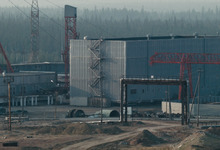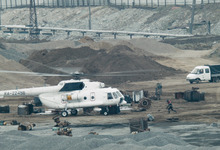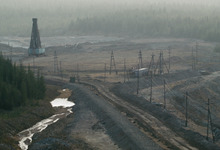- Images (3)
- Liens (1)
- Agenda

|

|

|
Objects and Artifacts (2019) by Viktor Brim is part of the Atelier 105 film program that you can watch here from Monday 22 to Sunday 28 February 2021.
Where exactly is the "post-apocalyptic landscape" of this film located and how did you get there?
Objects and Artifacts was filmed in Yakutia and the Murmansk Oblast of the Russian Federation. Both are areas known for their heavy industry. I was interested in these areas in regard to their strategic importance for the Soviet Union as well as Russia today. In these places, vast amounts of mineral resources are extracted, including nickel, oil, diamonds, apatite, nepheline and gold. Both are also areas that are close to the Arctic Circle and thus have a significant impact on living and working conditions.
These areas are not truly representative of the Soviet Union, nor are many aware of their importance. When people talk about specific places of Russia or the USSR, they usually refer to Moscow or Saint Petersburg. And yet these places were of enormous importance in terms of economic and geopolitical supremacy. Without access to these resources, history would have been written differently. In the patina of the ruins and rusting industrial complexes, so much historicity stands out, which has been deposited in the sedimentary layers of heavy metals over many decades.
Can you elaborate on the film's enigmatic title and on your formal approach as a filmmaker?
The title of the film refers to a way of dealing with the past that is very specific to the Russian landscape. Perhaps it has to do with the immense size of the country. Especially in places where many industrial complexes were built in a short period of time, there are many ruins of older versions of the built facilities. Ghost towns from the time of the USSR are very common. Traveling around Russia, I can't shake the feeling that the country has shrunk, as if a greater civilization and activity had taken place here before. The many ruins and old industrial zones from the Soviet era, which are still scattered all over the country like relics, seem to me like a kind of time capsule. In the film I have tried to capture these time capsules, which vegetate fluidly from one era to the next.
Can you tell us a bit more about your political and ecological concerns with the post-Soviet landscape?
In the project I was interested in understanding the confluence of ideology and its materialization within industrial localities or territories. The extraction of minerals and raw materials is directly linked to geopolitical strategies. This process is linked to intertwined questions of identity and nation. I have chosen a filmic form with little commentary to confront these questions because I think that cinematic aesthetics can create new connections on the perceptual level. I also think that the cinematic observation of the post-Soviet landscape can raise the question of a fundamental way of dealing with matter. Whether it is the Soviet multi-ethnic state or a new federal structure that orders, manages, and organizes the Russian landscape, the question of accountability on the global level remains the same. In my work, I try to confront this complexity with different stylistic approaches.
| lieu |
En ligne / Online Atelier 105 Paris France |
|---|---|
| lightcone@lightcone.org | |
| lien en relation |
ATELIER 105 EN LIGNE
|